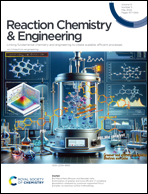Applying quantum mechanics to deconvolute benchtop 1H NMR reaction data†
Abstract
Deploying analytical tools for online reaction monitoring can reduce the time, labor, and material costs of synthesizing important compounds. Nuclear magnetic resonance (NMR) spectroscopy is especially powerful for this purpose because this inherently quantitative technique provides in-depth chemical structural information for each chemical species present in sample mixture in a single measurement. Recent developments in benchtop NMR spectrometers (≤125 MHz) have further increased access to NMR as a reaction monitoring tool by bringing the technology to the bench at a lower cost and without the need for cryogenic liquids. Despite such advancements, there are still relatively few examples of monitoring chemical reactions via benchtop 1H NMR experiments, due to challenges with reduced sensitivity and signal dispersion. Here, we propose a quantum mechanical spectral analysis (QMSA) based workflow for reaction monitoring to address the low signal dispersion challenge. In this automated workflow, QMSA calculations were performed using the software USP-ID, and data extraction was performed with a custom Python script. We used the workflow to successfully monitor epoxidation reactions conducted both on high-field (HF) and benchtop 1H NMR spectrometers. The proposed workflow was compared to the indirect hard modelling approach (IHM) and showed improved reaction monitoring results and better calibration transfer. Altogether, our results demonstrate the capability and accessibility of benchtop 1H NMR spectrometer with advanced QMSA software as a compelling reaction monitoring technique.



 Please wait while we load your content...
Please wait while we load your content...